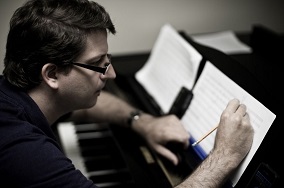 The pervading question for me has always been, “What is my music about?” It is a question that is, if asked at all, often an exercise in self-reflection; however, at one time or another, a composer may have the fortune (or misfortune as the case may be) of having others ask it about their music. Although I should be prepared with some kind of laconic response, I usually never know how exactly to approach answering that question.
The pervading question for me has always been, “What is my music about?” It is a question that is, if asked at all, often an exercise in self-reflection; however, at one time or another, a composer may have the fortune (or misfortune as the case may be) of having others ask it about their music. Although I should be prepared with some kind of laconic response, I usually never know how exactly to approach answering that question.
However, I do feel that my lack of a forthcoming answer to the question “What is my music about?” may, in itself, be a good starting point. Something tells me that, once I have finished a composition and I am unable to fully explain how it came to fruition, then I have perhaps succeeded to some degree in the compositional process. If the piece has an elliptical quality, I can only hope that it brings a listener back to it in the same way that I am drawn back to a piece that I don’t fully understand.
One could easily misinterpret my meaning here. I do not intentionally write esoteric music, nor do I plan to confuse the listener. The intent is very much the opposite. I am looking to make musical ideas and gestures that are clear and refined.
I am certain many composers might say the same thing. So what makes my music different? What are the brass tacks? How do I create music that aims to articulate the unarticulated?
***
I am interested in sounds as phenomena. I try to envision sounds as objects in space. Each sound is a sculpted, cultivated entity with its own identifying markers of texture and timbre: density, loudness, register, methods of production, and frequency spectrum.
My starting point for composing is usually with a sound or sounds that intrigue me. It can be a simple sound (an interval at the piano), or it can be a more complex sound (a noise-laden bell or gong). Once I find these sounds, I can explore ways to relate them either to themselves (by making patterns that gradually change to emphasize different aspects of the same sound), or to other sounds (by juxtaposing sounds and fitting them together in novel ways).
In my work “Interruptions II,” it is more often the former that occurs – patterns shifting, ideas being reiterated in slightly altered contexts, similar to viewing a sculpture at different angles.
[soundcloud url=”https://api.soundcloud.com/tracks/117184142″ width=”100%” height=”166″ iframe=”true” /]
In the case of “Monochrome Variations,” I am more interested in juxtaposition of ideas, as if there are two paintings covering the same space and vying for your attention.
[soundcloud url=”https://api.soundcloud.com/tracks/117184860″ width=”100%” height=”166″ iframe=”true” /]
In the case of “Binding Song,” I do a bit of juxtaposition and repetition. Ideas are reiterated (and slightly altered), and new ideas are woven into the fabric.
[soundcloud url=”https://api.soundcloud.com/tracks/117185583″ width=”100%” height=”166″ iframe=”true” /]
I strive to write music that exists in a kind of rarefied space. Silence (and near-silence) is always the starting point for sound. It is the framework within which sounds exist. I am intrigued by sound that approaches that starting point – that embraces the threshold between sound and silence – that exposes the seam between the audible and the inaudible. There is a kind of unexplored frontier in quiet sound worlds that reinforces that sense of rarefied space that I am after.
Philip Schuessler has had works performed nationally and internationally by such artists as violinist Graeme Jennings, Time Table percussion ensemble, violinist Eric km Clark, soprano Tony Arnold, Mantra Percussion, Dither Guitar Quartet, Yarn/Wire, and cellist Craig Hultgren. His music has been played at such notable venues as June in Buffalo Festival, Festival Miami, the Czech-American Summer Music Workshop at Florida State University, the CCMIX Summer Intensive Course in Electronic Music in Paris, International Computer Music Conference in Miami, MusicX in Cincinnati, the Oregon Bach Festival, Spark Festival, Electronic Music Midwest, and Electro-Acoustic Juke Joint. He received degrees from Birmingham-Southern College and the University of Miami, and he received his PhD from the State University of New York at Stony Brook. He is currently Instructor of Music at Southeastern Louisiana University.

